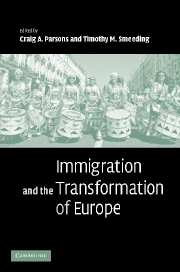Book contents
- Frontmatter
- Contents
- List of figures
- List of tables
- List of contributors
- Acknowledgements
- 1 What's unique about immigration in Europe?
- 2 Europe's immigration challenge in demographic perspective
- 3 Migration into OECD countries 1990–2000
- 4 Divergent patterns in immigrant earnings across European destinations
- 5 Economic consequences of immigration in Europe
- 6 Occupational status of immigrants in cross-national perspective: A multilevel analysis of seventeen Western societies
- 7 Immigrants, unemployment, and Europe's varying welfare regimes
- 8 How different are immigrants? A cross-country and cross-survey analysis of educational achievement
- 9 Immigration, education, and the Turkish second generation in five European nations: A comparative study
- 10 Managing transnational Islam: Muslims and the state in Western Europe
- 11 Migration mobility in European diasporic space
- 12 The new migratory Europe: Towards a proactive immigration policy?
- 13 European immigration in the people's court
- 14 The politics of immigration in France, Britain, and the United States: A transatlantic comparison
- 15 “Useful” Gastarbeiter, burdensome asylum seekers, and the second wave of welfare retrenchment: Exploring the nexus between migration and the welfare state
- 16 The European Union dimension: Supranational integration, free movement of persons, and immigration politics
- 17 The effectiveness of governments’ attempts to control unwanted migration
- Index
- References
17 - The effectiveness of governments’ attempts to control unwanted migration
Published online by Cambridge University Press: 23 June 2009
- Frontmatter
- Contents
- List of figures
- List of tables
- List of contributors
- Acknowledgements
- 1 What's unique about immigration in Europe?
- 2 Europe's immigration challenge in demographic perspective
- 3 Migration into OECD countries 1990–2000
- 4 Divergent patterns in immigrant earnings across European destinations
- 5 Economic consequences of immigration in Europe
- 6 Occupational status of immigrants in cross-national perspective: A multilevel analysis of seventeen Western societies
- 7 Immigrants, unemployment, and Europe's varying welfare regimes
- 8 How different are immigrants? A cross-country and cross-survey analysis of educational achievement
- 9 Immigration, education, and the Turkish second generation in five European nations: A comparative study
- 10 Managing transnational Islam: Muslims and the state in Western Europe
- 11 Migration mobility in European diasporic space
- 12 The new migratory Europe: Towards a proactive immigration policy?
- 13 European immigration in the people's court
- 14 The politics of immigration in France, Britain, and the United States: A transatlantic comparison
- 15 “Useful” Gastarbeiter, burdensome asylum seekers, and the second wave of welfare retrenchment: Exploring the nexus between migration and the welfare state
- 16 The European Union dimension: Supranational integration, free movement of persons, and immigration politics
- 17 The effectiveness of governments’ attempts to control unwanted migration
- Index
- References
Summary
Introduction
In an increasingly interdependent world, rising numbers of asylum seekers and their highly unequal distribution across countries have meant that forced migration is now regarded as one of the key challenges facing nation-states today. This challenge is made even greater by the fact that one state's policy decisions on the relative leniency or restrictiveness of its asylum regime will create externalities for other states and can thus lead to strained relations between states. As a consequence, forced migration has also come to be seen as a crucial challenge for international policy coordination, leading, for example, to rapid advances in the efforts of the European Union (EU) to provide for effective policies in this area.
Policy-makers charged with finding an appropriate response to these challenges have been faced with two key questions: First, why have some states been faced with a much higher number of asylum applications than others? And second, what public policy measures, if any, can effectively influence the number of asylum seekers that a state receives? From a national perspective, the most frequent response to the first question has been to argue that if states' asylum burden is disproportionate, then these countries' asylum procedures are probably too lenient and their welfare provisions too generous in international comparison. By increasing the restrictiveness of their asylum policy, the argument goes, states will be able to redress the inequitable distribution of burdens, raising concerns in some quarters, however, about a possible race to the bottom of protection standards.
- Type
- Chapter
- Information
- Immigration and the Transformation of Europe , pp. 442 - 472Publisher: Cambridge University PressPrint publication year: 2006
References
- 44
- Cited by

